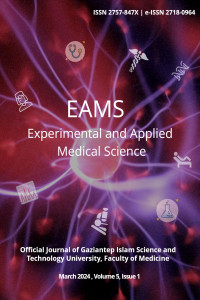Öz
Kaynakça
- 1. Page E, Kostantinis S, Karacsonyi J, et al. Incidence, treatment and outcomes of coronary artery dissection during percutaneous coronary intervention. The Journal of invasive cardiology. 2023;35(7):E341-e54.
- 2. Boyle AJ, Chan M, Dib J, et al. Catheter-induced coronary artery dissection: risk factors, prevention and management. The Journal of invasive cardiology. 2006;18(10):500-3.
- 3. Brilakis E. Manual of Percutaneous Coronary Interventions. In: Brilakis E, editor. Manual of Percutaneous Coronary Interventions: Academic Press; 2021.
- 4. Huber MS, Mooney JF, Madison J, et al. Use of a morphologic classification to predict clinical outcome after dissection from coronary angioplasty. The American journal of cardiology. 1991;68(5):467-71.
- 5. De Palma R, Aminian A, Muller O, et al. The prevention and management of complications during percutaneous coronary intervention. 2024. In: The PCR-EAPCI Percutaneous Interventional Cardiovascular Medicine Textbook [Internet]. Europa Group, [accessed 28.01.2024].
- 6. Prashant Ponangi U, Menon R, Kapadia A. Successful angioplasty of three cases of coronary artery dissections using hydrophilic wires. Postepy w kardiologii interwencyjnej = Advances in interventional cardiology. 2014;10(4):289-93.
Approach to a patient with iatrogenic coronary dissection during percutaneous intervention
Öz
This case report presents a conservative management approach to a potentially hazardous complication, iatrogenic coronary artery dissection (ICAD), occurring during percutaneous coronary intervention (PCI). The patient, a 60-year-old woman with a history of chronic hypertension and type II diabetes mellitus, presented with non-ST-segment elevation myocardial infarction. During the PCI, an antegrade coronary dissection was observed, leading to the termination of the procedure. Post-procedure, the patient was managed conservatively with standard coronary artery disease treatment. Follow-up angiography showed complete healing of the dissection area, and no adverse cardiovascular events occurred during a 3-month follow-up period. This report highlights the importance of early diagnosis and careful management of ICAD. It stresses the need for further research into long-term outcomes and effectiveness of different treatment approaches for patients with ICAD.
Anahtar Kelimeler
Iatrogenic coronary artery dissection, percutaneous coronary intervention conservative management hydrophilic wire complications
Kaynakça
- 1. Page E, Kostantinis S, Karacsonyi J, et al. Incidence, treatment and outcomes of coronary artery dissection during percutaneous coronary intervention. The Journal of invasive cardiology. 2023;35(7):E341-e54.
- 2. Boyle AJ, Chan M, Dib J, et al. Catheter-induced coronary artery dissection: risk factors, prevention and management. The Journal of invasive cardiology. 2006;18(10):500-3.
- 3. Brilakis E. Manual of Percutaneous Coronary Interventions. In: Brilakis E, editor. Manual of Percutaneous Coronary Interventions: Academic Press; 2021.
- 4. Huber MS, Mooney JF, Madison J, et al. Use of a morphologic classification to predict clinical outcome after dissection from coronary angioplasty. The American journal of cardiology. 1991;68(5):467-71.
- 5. De Palma R, Aminian A, Muller O, et al. The prevention and management of complications during percutaneous coronary intervention. 2024. In: The PCR-EAPCI Percutaneous Interventional Cardiovascular Medicine Textbook [Internet]. Europa Group, [accessed 28.01.2024].
- 6. Prashant Ponangi U, Menon R, Kapadia A. Successful angioplasty of three cases of coronary artery dissections using hydrophilic wires. Postepy w kardiologii interwencyjnej = Advances in interventional cardiology. 2014;10(4):289-93.
Ayrıntılar
| Birincil Dil | İngilizce |
|---|---|
| Konular | Kardiyoloji |
| Bölüm | Vaka Raporu |
| Yazarlar | |
| Erken Görünüm Tarihi | 1 Nisan 2024 |
| Yayımlanma Tarihi | 6 Mart 2024 |
| Gönderilme Tarihi | 5 Şubat 2024 |
| Kabul Tarihi | 2 Mart 2024 |
| Yayımlandığı Sayı | Yıl 2024 Cilt: 5 Sayı: 1 |

